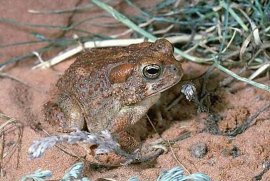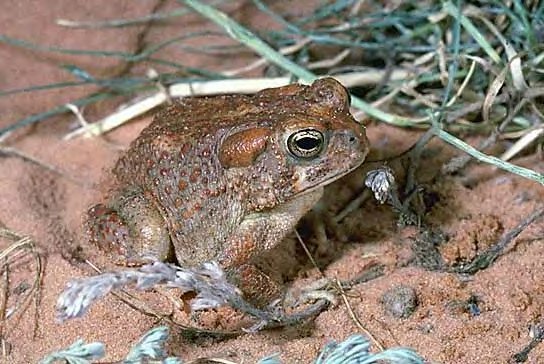Frogs and Toads
Description
2-3" (5.1-7.7 cm). Medium-sized plump toad, olive to brown to pink, with or without dark spots. Usually has light stripe or patch on head and back. Parotoid glands oval, widely separated; forward ends light-colored. No cranial crests. Male throat not dark.
Endangered Status
The Arroyo Toad, a subspecies of the Southwestern Toad, is on the U.S. Endangered Species List. It is classified as endangered in California. The range of the Arroyo Toad in California is now about one-quarter the size it once was. The species has lost much of its habitat (slow-moving gravelly or sandy-bottom streams) to encroaching development, agriculture, water-management, and other practices. The introduction of alien species, such as bullfrogs and fish, which prey on Arroyo Toads, as well as exotic plants that cause changes to the nature of the habitat, has also taken a toll. Among the measures being taken to help this species survive are curtailing development projects during the breeding season, reducing the impact such projects have on the toads’ habitat, relocating toads found in compromised areas, and protecting the habitat from pollution and human disturbance.
![]()
Warning
Toads have enlarged glands (called the paratoid glands) on the side of the neck, one behind each eye. These glands secrete a viscous white poison that gets smeared in the mouth of any would-be predator, inflaming the mouth and throat and causing nausea, irregular heart beat, and, in extreme cases, death. Toads pose a danger to pets, which may pounce on and bite them. Humans should take care to wash their hands after handling a toad, and to avoid touching the mouth or eyes until having done so.
Subspecies
Arizona (B. m. microsaphus), with dark
spots on back; scattered populations along the headwaters and
tributaries of the Colorado River from sw. Utah, s. Nevada, c.
Arizona, and sw. New Mexico, into Mexico.
Arroyo (B. m.
californicus), with fewer spots on back, back warty; sw. California
into nw. Baja California.
Voice
A pleasing musical trill; ends abruptly after 10 seconds.
Breeding
March to July; not dependent on rainfall. Egg strings are laid on bottom of pools.
Habitat
Loose gravelly areas of streams and arroyos in drier portion of range; often on the sandy banks of quiet water in other areas.
Range
Coastal s. California and n. Baja California. Scattered localities in Utah, Nevada, Arizona, and New Mexico.


